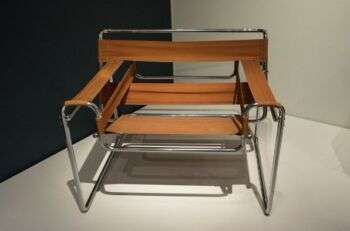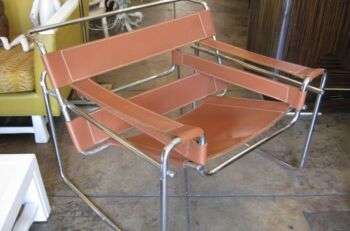Marcel Breuer designed the Wassily Chair, also known as the Model B3 chair, in 1925-1926 while he was the head of the Bauhaus cabinet workshop.

Image source: https://search.creativecommons.org/photos/2c69215f-e6ac-41ea-aea2-d6b272f31b67 by Tim Evanson
Design Concept

Image source: https://search.creativecommons.org/photos/841a4f3e-f7fb-443e-a187-922a4258d0a5 by moonoa
While teaching at the Bauhaus, Breuer often rode a bicycle. His pastime led him to what is perhaps the single most important innovation in furniture design in the twentieth century: the use of tubular steel. The material of his bicycle’s handlebars is strong and lightweight. Taking this into account, Breuer reasoned that if it could be bent into handlebars, it could be bent into furniture forms.
Inspired by the constructivist theories of the De Stijl movement, Marcel Breuer was still an apprentice at the Bauhaus school when he stripped the classic club chair to its basic lines and shapes, forever changing the course of furniture design.
This chair was revolutionary in its use of materials and methods of manufacturing. Additionally, the design (and all subsequent steel tubing-based furniture) was only feasible because the German steel manufacturer Mannesmann had recently perfected a process for making seamless steel tubing. Previously, steel tubing had a welded seam, which collapses when the tubing bends.

Image source: https://search.creativecommons.org/photos/affb4f80-b765-465b-8845-106aa92b8471 by oswaId
The base model for this chair is the traditional-overstuffed club chair. Yet, all that remains after Breuer’s intervention is a mere outline which is an elegant composition traced in gleaming steel. As a result, the canvas seat, back, and arms seem to float in space. Further, the body of the sitter does not touch the steel framework.
Artist-Inspired Chair

Image source: https://search.creativecommons.org/photos/02c79514-d129-4a69-bde1-a28b596e29a6 by mole555
The chair was not for the abstract painter Wassily Kandinsky, who at the same time was part of the faculty of the Bauhaus. Kandinsky had admired the completed project, and Breuer duplicated it for Kandinsky’s quarters. Decades later, the chair was republished as “Wassily” by the Italian manufacturer Gavina, who learned of this anecdote about Kandinsky during his research on the origins of the chair.
The Wassily Chair Project
The model of the chair, designed in 1925, underwent several transformations through time, In 1927, the frame reached its current position, consisting of a continuous tube (without joints) that circumscribes the frame, folding a cubic space several times.
Initially, the Wassily Chair was produced by the company founded by Breuer of Standard-Mobel Lengyel, in 1929, which was by Thonet.
The version of the chair produced by Thonet is rare and went out of production during World War II.
After the decades of war, Gavina picked up the license for the Wassily, along with the Breuer models previously sold by Standard-Möbel, Lengyel & Co. After which, he introduced the more recognized Wassily version and replaced the fabric with black leather straps. In 1968, Knoll bought the Gavina Group of Bologna, which brought all of Breuer’s design to the Knoll catalog.

Image source: https://search.creativecommons.org/photos/95415e1d-66c5-47ee-b970-fcc55ece7b70 by lacasavictoria
The Wassily chair, like many other designs from the modernist movement, has been mass-produced since the late 1920. Additionally, it has been in production since the 1950s and is still available today. Though the patents expired, Knoll of New York City own the rights to the brand name on the design. Reproductions are produced worldwide by other manufacturers, who market the product under different names.
Data Sheet
Designer: Marcel Breuer
Year: 1925
Producer: Knoll
Structure: tubular steel with polished chrome finish. Seat in leather or Cordura. Each chair comes with the feet in molded plastic, easily applicable to the base, if necessary (for hard floors).
Finishes: Leather upholstery in thick black, brown, tan, gray, or white-beige. The Cordura fabric is in black, brown, blue, green, gray, or red.
Dimensions: L 79 cm x 70 cm D x 72 cm, seat height: 42 cm

Image source: https://search.creativecommons.org/photos/e7796c32-65ad-4bf8-bea1-3b62d3a5ef17 by mandiberg
Info sources:
http://www.designindex.org/products/design/wassily-chair.html
